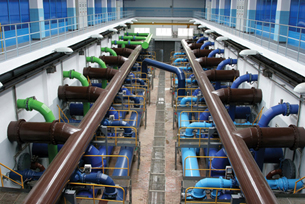Module 8 Intro
1. Module 8 Intro
1.1. Big Picture
Module 8—Circulation, Immunity, and Excretion
 Big Picture
Big Picture

© Tomasz Szymanski/shutterstock
When you turn on the tap to fill a glass with water to drink, do you ever stop to consider how that water was circulated, filtered, and purified of water-borne parasites to make it safe to drink? Or do you just take it for granted that there is a process the water goes through to end up in your glass?
For that matter, you probably also take it for granted that your body has a way to filter, purify, and circulate blood, remove wastes, and has a system to protect you from being sick all the time.
Many parallels can be drawn between a water treatment plant and human body systems in relation to circulation, immunity, and excretion.

© Sebastian Kaulitzki/shutterstock
The closest parallel would be the function of filtration. Water moves through a series of processes that filter out contaminants. Clean water is reintroduced to the environment. Wastes are collected and stored until they can be disposed. Similarly, blood moves through millions of filtering structures within the kidney. Once toxins and metabolic wastes are removed, filtered blood is reabsorbed and continues on its journey to the rest of the body. Waste, in the form of urine, is collected by the bladder and excreted.
Another parallel can be made between a water treatment plant and the circulatory system. A sophisticated network of pipes and valves control the movement of natural water which may be contaminated into a treatment plant and clean water back out to the environment. In humans, a complex network of blood vessels move oxygenated and deoxygenated blood to and from the heart. The heart, which is a powerful pump containing a series of valves, sets the rhythm for the movement of blood.
Finally, a parallel can be drawn between the processes involved in treating the water in a water treatment plant and the immune system. As water moves through a treatment plant, substances and living organisms are added to the water to rid it of biological contaminants. In the body, different types of cells are produced which interact with foreign substances. The foreign substances are then dissolved and reabsorbed or filtered out by the kidneys.
As in the human body, all parts of a water treatment plant work together to support function and a balanced system.
In this module you will explore this question: How do the circulatory, immune, and excretory systems maintain internal equilibrium through matter and energy exchange?
As you work through this module you will explore the following essential questions:
- What are the major structures and functions of the circulatory, immune, and excretory systems?
- How do the principle structures of the circulatory system move blood through the body?
- What is the relationship between blood pressure, heart rate, and exercise?
- How can technology treat disorders of the circulatory, immune, and excretory systems?
- What are the main components of blood, and how do they look under a microscope?
- How does blood help to regulate body temperature?
- At the capillary level, how does the circulatory system aid the digestive, excretory, respiratory, and motor systems’ exchange of matter with the environment?
- How do the cellular and non-cellular components of the human defense system work together to maintain homeostasis?
- How do antigens identify blood types and Rh factors?
- How does the nephron function in maintaining the composition of blood plasma?
- How do the kidneys function in excreting metabolic wastes and expelling them into the environment?
- How do the kidneys contribute to homeostasis in terms of water and ions?
- How does the design of the kidney relate to dialysis technologies?
In addition to the lesson assignments and labs, there will be a module project to complete. For the module project you will have the choice between three extended responses. The purpose of an extended response is to help you take a closer look at a specific area of study. In the module project you will choose between investigating the heart, an immune response, or a disease of the kidney.
When you are ready for more information about the project, go to the Module Summary for instructions.